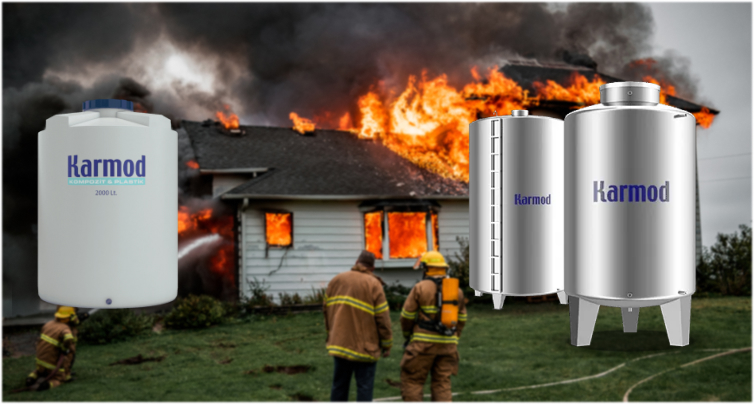
In our country, the most common natural disasters we face are earthquakes. However, despite being less frequent, we have also been exposed to disasters like fires, especially with recent forest fires in the area. Among the preventive measures used for fire incidents, polyethylene water tank models have gained importance. These tanks are used not necessarily to combat all fires but primarily for initial intervention. This initial response is crucial to prevent fires from spreading. It's a concept often expressed as "nip it in the bud." Extinguishing a fire when it's small prevents it from growing. So, how should these tanks be used for fire protection, and which ones are more suitable? These are some of the questions we encounter, and we have researched and provided answers.
Which Water Tank Is Best Suited for Use During Fires or Other Natural Disasters?
Whether organic or containing chemical substances, these tanks, used for storing various contents, are manufactured using three different raw materials. We will focus on tanks that should be used during emergencies and natural disasters. One crucial factor to understand in such situations is that these tanks are purchased for emergency use, meaning the stored water or different chemical contents may sit for extended periods. These tanks are designed to preserve the stored content for an extended duration. However, the ambient temperature has a significant impact on this. We will assess the effects of the materials used in tank manufacturing during use. Here are the characteristics of these tanks:
Stainless Steel Water Tank
Tanks obtained from stainless steel are known for their robustness. Unlike other tanks, their rigid structure makes them more earthquake resistant. Additionally, their light insulation capabilities allow the stored content to remain preserved for extended periods. Moreover, when you purchase a large vertical stainless steel water tank, it can even create a life triangle during earthquakes. This can facilitate reaching people who cannot evacuate buildings in the event of an earthquake, improving the chances of rescue. However, if tons of debris fall on it during the earthquake, it may become unusable. Still, this situation can often be repaired. These tanks are also very suitable for use during fires. Water or fire extinguishing chemicals can be stored inside, and by connecting the drainage valve to the fire extinguishing system, automatic use can be ensured during a fire. From this perspective, they are highly effective against fires.
To provide an extreme example, let's assume that a fire breaks out in the area where the tank is located. Thanks to the steel's high-temperature tolerance (up to +80 degrees Celsius), if immediate action is taken to combat the fire, there should be no problem. Even in an extreme scenario of a fire lasting for hours, some sections of the tank may burn. However, even in such an extreme case, these tanks are highly resilient.
Polyester Water Tanks
Tanks manufactured using polyester primarily stand out due to their chemical resistance. These tanks are considered a sought-after element in the manufacturing industry. They can also perform effectively in emergency situations and natural disasters, almost as well as tanks made of stainless steel. Both stainless steel tanks and polyester storage products offer on-site assembly capabilities. This feature allows for customized tank designs according to the location where it will be positioned. In case of an earthquake, a space that can create a life-saving triangle can be arranged.
Looking at the production process, polyester possesses a rigid yet flexible structure. Simply put, it's obtained by combining polyester resin and fiberglass. Its chemical resistance can be highly functional in the context of fire. Water isn't a very effective extinguishing agent for fires. Firefighters typically use chemicals like those found in fire extinguishers to combat fires. Polyester-made products are the most suitable storage solution to transport this material without any significant deterioration. The chemical resistance of these tanks is achieved through isophthalic, and epoxy-based vinyl ester resins integrated into the production formula.
In the case of natural disasters like floods and landslides, if the structure they are in remains intact, polyester tanks remain undamaged. However, if a storage product is placed outdoors, it will likely need to be relocated. If it contains a heavy load, it may remain stationary like a post, but this entirely depends on the environment it's placed in.
Polyethylene Water Tanks
Storage products produced using polyethylene are known for their economic prices and lightweight construction. They are capable of handling fire incidents almost as effectively as stainless-steel tanks. When connected to a fire extinguishing system, they will automatically activate through the drainage valve. Due to the flexible nature of polyethylene, it's an adaptable material. Furthermore, the production of these tanks is streamlined, following a Monoblock production method. Tanks are produced as a single unit by pouring polyethylene into molds specially prepared for tank design. Unlike others, these storage products come with the most budget-friendly price tags. However, their resilience against natural disasters, such as earthquakes, is somewhat lower compared to others. If faced with natural disasters like floods and landslides, their durability will vary depending on the location where they are situated.
You can prepare for natural disasters or emergencies like fires by purchasing one of these tanks, which offer numerous advantages. You can explore their models on our website and contact our customer representatives for more information.


 EN
EN
 DE
DE
 FR
FR
 IT
IT
 ES
ES
 PT
PT
 RU
RU
 AR
AR
 BG
BG
 SR
SR
 GR
GR
 SQ
SQ
 RO
RO
 PL
PL
 HU
HU
 CZ
CZ
 HR
HR
 AZ
AZ
 GE
GE
 AM
AM
 IL
IL